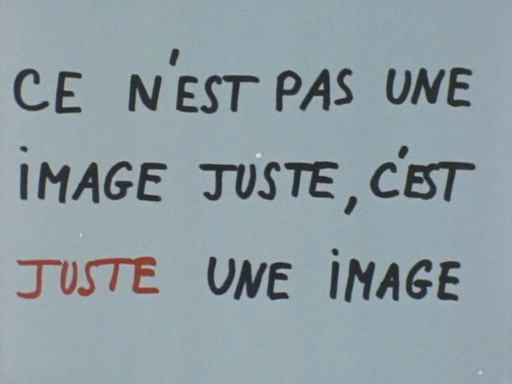
By Serge Daney
Originally published as ‘Le thérrorisé (pédagogie godardienne)’, Cahiers du Cinéma 262-3 (January 1976). This version is based on translations by Annwyl Williams and Bill Krohn / Charles Cameron Ball.
Learning, retaining
May ’68, as we know, confirmed Godard’s suspicion that the movie theater was, in every sense, a bad place, at once immoral and inadequate. A place for facile hysteria, for the eye’s filthy roving, for voyeurism and magic. The place where, to revive a metaphor which has had its moment of glory, one came to “sleep in the image bed” (dormir dans le plan lit), to get an eyeful and blind oneself in the process, to see too much and to see badly. (1)
The doubts cast by May ’68 on the “society of the spectacle”, a society which secretes more images and sounds than it can see and digest (the image runs past, recedes, runs away) – affected the generation that had invested most in it, that of the self-taught cinephiles for whom the movie theatre had taken the place of both school and family, the generation of the Nouvelle Vague, brought up in the cinematheques. From 1968 Godard was to react by pulling out and retracing his steps: from the cinema to school, and then from school to the family. Regression? Why not say “regressism”?
In 1968, for the most radical – the most leftist – fringe of filmmakers, one thing is certain: you have to learn to get away from the movie theater (from cinephilia, from obscurantism) or at least connect it to something else. And to learn you have to go to school. Not so much the “school of life” than to the cinema as school. That was how Godard and Gorin came to transform the scenographic cube into a classroom, the film dialogue into a recitation, the voice-over into a lecture, the shooting into a practical, the film topic into course headings (“revisionism”, “ideology”) and the film-maker into a schoolmaster, tutor or supervisor. School thus becomes the good place which removes us from cinema and reconciles us with “reality” (a reality to be transformed, naturally). It’s the place which has brought us the films of the Dziga-Vertov group (and already, La Chinoise). In Tout va bien, Numéro deux and Ici et ailleurs the family apartment has replaced the classroom (and television has taken the place of the cinema), but the essential remains. The essential: people learning a lesson.
We need look no further to explain the extraordinary precipation of love and hatred, of rage and irritation, the moans and the groans that Godard’s “cinema” – pursuing a fairly rough Maoist pedagogy, initially – proceeded to unleash. Had Godard been “recuperated by the system”, people would have forgiven him a lot (even today, how many people are still indignant at the idea that he won’t give them another Pierrot le fou?). Had he become totally marginalized, an underground figure happy with his underground status, they would have rendered him discreet homage. But what can they do with a Godard who continues to work, to teach and be taught, whether people come to see his films or not? There’s something in Godardian pedagogy that cinema – cinema especially – cannot tolerate: the fact that it is addressed to no one in particular.
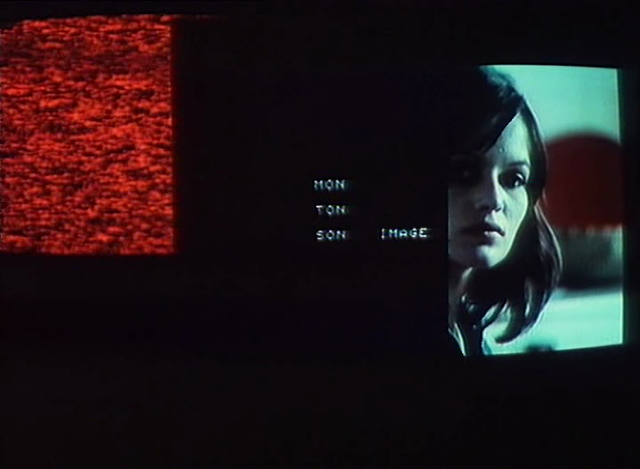
Godardian Pedagogy. School, as we were saying, is the ‘good place’ (where you make progress and from which you must move on) in contrast to cinema (the bad place where you regress and never move on). Let’s take a closer look and pursue the metaphor.
1. School is preeminently the place where it is possible, permitted and even recommended to mix up words and things – not wanting to know what links them, putting off until later the moment when one must go examine more closely (what corresponds to what one has been taught). A place which calls for nominalism, dogmatism.(2)
Now there was a sine qua non for the Godardian pedagogy: never questioning the discourse of the other, whoever he is. Simply taking this discourse literally, and taking it at its word. Concerning oneself only with the already-said-by-others, with what has been already-said-already-established in statements (indiscriminately: quotations, slogans, posters, jokes, stories, lessons, newspaper headlines. etc.) Statement-objects, little monuments, words treated as things: take them or leave them.
The already-said-by-others confronts us with a fait accompli: it has in its favor existence, solidity. By its existence it renders illusory any approach which would try to reestablish behind, before or around it a domain of enunciation. Godard never puts to the statements that he receives the question of their origin, their condition of possibility, the place from which they derive their legitimacy, the desire which they at once betray and conceal. His approach is the most anti-archeological there is. It consists of taking note of what is said (to which one can add nothing) and then looking immediately for the other statement, the other sound, the other image which would counterbalance this statement, this sound, this image. “Godard,” then, would simply be the empty place, the blank screen where images, sounds come to coexist, to neutralize, recognize and designate one another: in short, to struggle. More than “who is right? who is wrong?,” the real question is “what can we oppose to this?” The devil’s advocate.
Hence the malaise, the “confusion” with which Godard is often reproached. To what the other says (asserts, proclaims, extols) he always respond with what another other says (asserts, proclaims, extols). There is always a great unknown in his pedagogy, and that is the fact that the nature of the relationship he maintains with his “good” discourses (those he defends) is undecidable.
In lci et ailleurs, for example, for example, a “film” about images brought back from Jordan (1970-1974), it is clear that the film’s self-interrogation (the kind of disjunction it effects in every direction: between here and elsewhere, images and sounds, 1970 and 1975) is possible and intelligible only because, early on, the syntagm “Palestinian revolution” already functions as an axiom, as something which is a matter of course (something already-said-by-others, in this case, by Al Fatah), and in relation to which Godard does not have to define himself personally (to say “me, I,” but also to say “me, I am with them”), or to mark his position in the film (to socialize, make convincing, desirable, the position he has taken, his initial choice: for the Palestinians, against Israel.) Always the logic of school.
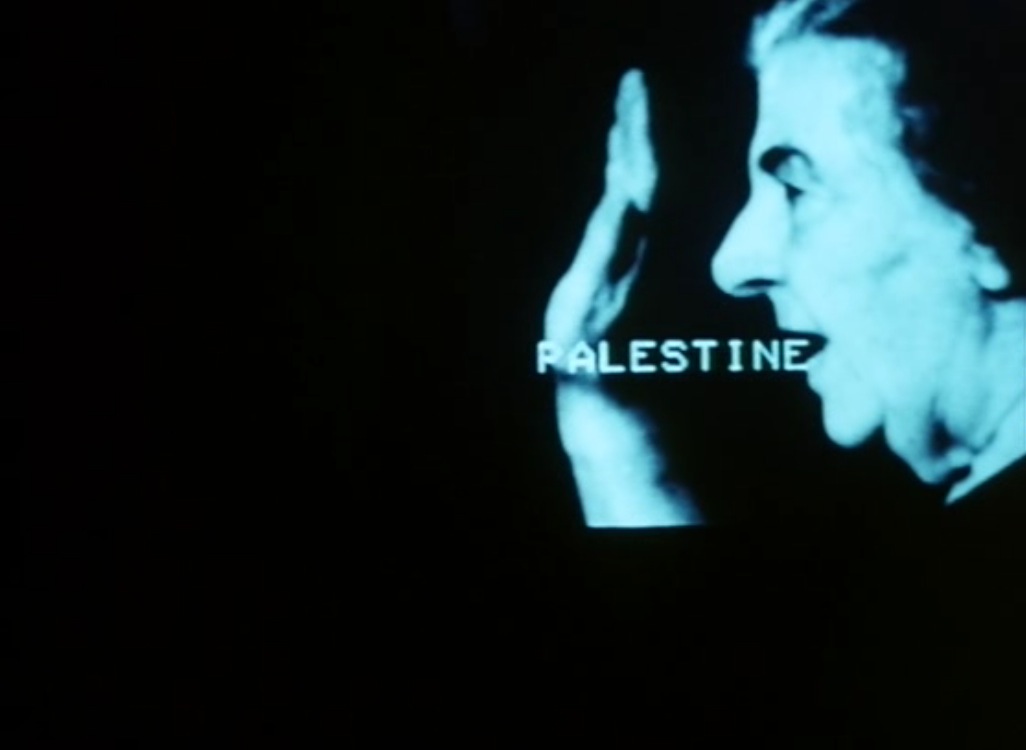
2. School is preeminently the place where the master does not have to say where his knowledge or his certainties come to him from. School is not a place where the pupil can reinscribe, use, put to the test the knowledge that has been inculcated in him. Beneath the master’s knowledge, beyond the student’s knowledge: a blank. The blank space of a no man’s land, of a question which Godard does not want to know anything about, the question of the appropriation of knowledge. He is only interested in (re)transmission (3).
And yet in every pedagogy there are values, positive contents, to be communicated. Godardian pedagogy is no exception to this rule. Every single one of the films made after 1968 latches on to (and protects itself from) what one might call- without any pejorative nuance – a discours du manche*. Let’s recapitulate: marxist-Leninst politics (the Chinese positions) in Pravda and Le Vent d’est, Althusser’s lesson concerning ideology as misstep in Lotte in Italia, Brecht’s lesson on “the role of intellectuals in the revolution” in Tout va bien and, more recently, bits of feminist discourse (Germaine Greer) in Numéro Deux. The discours du manche changes hands, so to speak, but it always comes from above and is quick to lay blame (the successive reproaches: being a cinephile, being a revisionist, being cut off from the masses, being a male chauvinist).
But Godard is not the conveyor – still less the originator – of the discourse which he asks us to believe in (and submit ourselves to), but something like the tutor (répétiteur). So a three-term structure is established, a little theatre à trois, where the master (who is after all only a tutor) and the pupil (who only repeats) meet up with the agency who says what has to be repeated. The agency of the discours du manche to which master and pupils are subjected, if unequally, and which harasses them.
The screen, then, becomes the place of this harassment and the film its mise-en-scène. Nevertheless, two questions are completely eluded in this dispositive: that of the production of the discours du manche (in Maoist terms, the question “where do correct ideas come from?”), and that of its appropriation (in Maoist terms, “the difference between true ideas and correct ideas”). School is of course not the place for these questions. There the tutor embodies a figure at once modest and tyrannical: he must recite a lesson which he knows nothing about and which he himself endures. (4)
This master-discourse is, after 1968, more or less systematically conveyed by the voice of a woman. For Godardian pedagogy implies a division of roles and discourses according to sex. Men’s speech, women’s discourse. The voice which reprimands, resumes, advises, teaches, explains, theorizes and even t(h)errorizes is always a woman’s voice. And if this voice begins to talk precisely about the question of women, it is still in an assertive, slightly declamatory tone: the opposite of the lifelikeness and plaintiveness of naturalism. Godard does not film any revolt which cannot speak for itself, which has not found its language, its style, its theory. In Tout va bien, we see the character played by Jane Fonda move very quickly from dissatisfaction to a kind of theoretical explanation of her dissatisfaction (one that Montand doesn’t understand). There is nothing beneath discourse, beneath already-said-by-others. (5)

3. for the master and for the pupils, each year brings with it (“back to school”) a mincing, a simulacrum of the first time, a return to zero: zero of no-knowledge, zero of the blackboard. So that school, the place of tabula rasa and the blackboard on which nothing remains for long, the gloomy place of waiting and suspense, of the transition to life, is an obsessional place: non-linear and closed.
From his very first films Godard has felt an extreme reluctance to “tell a story”, to say “in the beginning there was/at the end there is.” Getting away from the movie theater was also getting away from this obligation, well formulated by old Fritz Lang in Le Mepris: “You must always finish what you have started.” A fundamental difference between school and cinema: one doesn’t have to please, to flatter the students, because school is obligatory. It’s the she state insisting on schooling for every child. Whereas in cinema, in order to retain one’s audience, one must give them something to see and enjoy, tell them stories (hodgepodges): hence the accumulation of images, hysteria, calculated effects, retention, discharge, happy endings: catharsis. The privilege of school: there one retains students so that they will retain lessons, the master retains his knowledge (he doesn’t say everything) and punishes bad students with detention. (6)
Holding, returning
School was therefore the good place only because, as the very place of différance*, it allowed to retain the maximum number of things and people for the longest possible time. For “to retain” means two things: “to hold” but also “to delay,” “to defer.” To hold an audience of students in order to delay the moment when they would risk passing too quickly from one image to another, from one sound to another, seeing too quickly, come to premature conclusions, thinking they’re done with images and sounds when they have no idea to what extent the arrangement of these images and sounds is something very complex and serious, and not at all innocent. School allows to turn cinephilia against itself, to turn it inside out like a glove, taking all the time needed. This is why Godardian pedagogy consists of unceasingly returning to images and sounds, designating them, repeating them, commenting on them, reflecting them, criticizing them like so many unfathomable enigmas: not losing sight of them, keeping them in sight, holding on to them.
A masturbatory pedagogy? No doubt. It has as its horizon, as its limit, the enigma of enigmas, the sphinx of the still photograph: that which defines the intelligence that can never exhaust it, that which retains the look and the meaning, fixes the scopic impulse: retention in action.
For the place from which Godard is speaking to us, from which he addresses us, is certainly not the secure place of a profession or even of a professional project. It is an in-between, in-between three things, in fact, an unfeasible place which embraces the photograph (19th century), as well as cinema (20th century) and television (21st century.) The photograph: that which retains once and for all (a corpse to be worked on). Cinema: that which retains for a moment only (death at work). Television: that which retains nothing at all (a fatal spilling out, the hemorrhaging of images).(7)

Godard’s lead over other manipulators of images and sounds stems from his total contempt for any discourse on the “specificity” of cinema. You have to see how he places, how tranquilly he embeds both the still photograph and the television image in the cinema screen (cinema’s only specificity now consisting in – provisionally? – receiving images that are not made for it, in allowing itself to be invested by them: Numéro deux), to understand that Godard exceeds all discourse on the specificity of cinema, whether it be the spontaneous discourse of the spectator (this is what cinema means for me), the self-interested discourse of people in the business (you have to make films like this) or that of the enlightened university critic (this is how cinema functions).
The cinema, as we were saying at the beginning of this article, as a bad place, a place of crime and magic. The crime: that images and sounds are taken (snatched, stolen, extorted) from living beings. The magic: that they are exhibited in another place (the movie theater) for the pleasure of those who see them. The one who benefits from the transfer: the filmmaker. That’s where the real pornography lies, in this change of scene: it’s really the ob-scene.
It will be said: this is a moral and Bazinian question, and what’s more, this type of symbolic debt can’t be repaid. Indeed. But Godard’s itinerary happens to be the sign of a very concrete, very historical question, a question in crisis: that of the nature of what might be called the “filmic contract” (filming/filmed). This question seemed to pose itself only to militant or ethnographic cinema (“Us and the others”), but Godard tells us that it concerns the very act of filming. Is he exaggerating? One can’t seriously think that this is one of those questions that can be resolved with good will and pious hopes (for the good cause – the artistic masterpiece or the correct militant action). It is going to be raised and is bound to become more pressing as the traditional contract between filmer, filmed and spectator, the contract established by the film industry (Hollywood), becomes ever more threadbare and cinema, as “mass-art-family-oriented-popular-and-homogenizing” reaches crisis point. Godard speaks to us already about this crisis, because it was this crisis that made him into a filmmaker. But it’s already a question for pornographic cinema (Exhibition) or militant cinema (Un simple exemple). A question of the future.
For Godard, retaining images and his audience, pinning them down in a sense (as is cruelly done with butterflies), is a despairing activity, and a hopeless one. His pedagogy has gained him only time. To the obscenity of appearing as auteur (and beneficiary of filmic surplus-value), he has preferred that of exhibiting himself in the very act of retention.
The impossibility of obtaining a new type of filmic contract has thus led him to hold on to (to retain) images and sounds without finding anyone to whom he can return them, restitute them. Godard’s cinema is a painful meditation on the theme of restitution, or better, of reparation. Reparation means returning images and sounds to those from whom they were taken. It also means committing them (a truly political commitment) to produce their own images and sounds. And all the better if that production obliges the filmmaker to change his own way of working!

There is a film in which this restitution-reparation takes place, ideally at least: Ici et Ailleurs. These images of Palestinian men and women that Godard and Gorin, invited by the PLO, brought back from the Middle East, these images to which he has held on for five years – to whom should they be returned?
To the general public eager for sensation (Godard + Palestine = scoop)? To the politicized public anxious to be confirmed in its orthodoxy (Godard + Palestine = good cause + art)? To the PLO who invited him, allowed him to film and trusted him (Godard + Palestine = propaganda weapon)? Not even them. So?
One day, between 1970 and 1975, Godard realizes that the soundtrack has not been translated in its entirety – what the fedayeen are saying in the shots where they appear has not been translated from Arabic. And that in the end no one would be very bothered by this (accepting that a voice-over would cover these voices). Now, Godard tells us, these fedayeen whose speech has remained a dead letter are dead men with a reprieve, living dead. They – or other fedayeen like them – died in 1970, assassinated by Hussein’s troops.
Making the film (“You must always finish what you have started”) then amounts, quite simply, to translating the soundtrack, making sure one can hear what is said, or better, that one listens to it. What was retained is released, what was held is restituted, but it is too late. Images and sounds are rendered as honors are rendered, to those to whom they belong: to the dead.
——————————————————————————————————————————————————————-
Notes by Serge Daney
(1) The bourgeoisie talks of representation. But what does it mean by that?
In ten seconds you will be facing a character, a bourgeois screen. He’s a character from a western, a psychological drama, a police flick or a historical film. It doesn’t matter. In fact, it is always a seducer. He describes the room where you are sitting.
1. He says you’re in the dark.
2. He says there are more people on the balcony.
3. He says there is an old man in the fifth row.
4. He says there is a nice girl behind him.
5. He says he feels like fucking. He feels like giving her flowers.
6. He asks her to come with him on the screen.
7. There is verdure.
8. The sky is blue.
9. The air is clear.
10. You don’t believe it? You only have to turn up, bunch of morons!
11. Wonderful summer day
12. Sun
13. Truth
(2) In Numéro deux, words are things. In between the rare moments where they make sense, the letters inscribe in the heart of the black screen only the enigma of their form: hieroglyphs. Sense becomes no more than a particular instance of non-sense, Just as life is a particular instance of death – and a fairly uncommon one at that. Who wants these images, these sounds, these letters? Who is letting us see, hear or read them? Certainly not an ‘auteur’ (origin and property). Godard is, in the most modest sense, a manipulator.
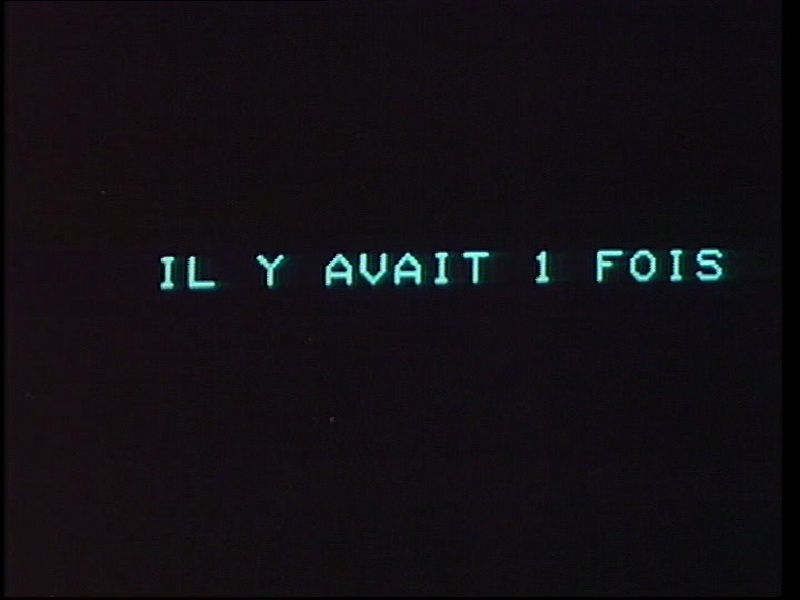
(3) The role of the educator has become, over the years, suspect and joyless. But there was a time when it was desirable. Jacques Rancière reminds us that Althusser’s teaching was aimed in the first place at the “regeneration of leaders through theory” (“leaders” = those of the French Communist Party). To which he rightly adds, “You could therefore say, stretching the point a little, that the political model assumed by this problematic was the very model of the educator’s philosophy: enlightened despotism.” A position of power that implied two possible relations: either the party leaders had to become philosophers, and that’s what Althusser was trying to achieve, or else the philosophers had to become party leaders, and that was what happened with the Union des Jeunesses Communistes (Marxistes-Leninistes). See La Leçon d’Althusser (p. 106).
(4) Appropriation is inversely a key notion for militant cinema, it’s what makes it a militant cinema in the first place. Something in the order of a credo, a party line, a demonstration – always an example – has to be passed on. Film is merely the element in which it is carried out: the “combustion” of opaque signifiers into organizing, transforming signifieds. We recite (restitute) a lesson (that’s didacticism) whereas we follow (appropriate) an example.
Following an example is to make it one’s own, to pass directly to the stage where an example is adapted to a concrete situation. The example is necessarily transformed and even travestied. Who would be bold enough to say that they know how experiences of struggle are communicated (other than “parties” small enough to create their reality and keep a tight rein on the communication of first-hand accounts and other experiences – always the logic of the mass educator)?
To make militant films is to accept this dispossession, to recognize that the process of appropriation always involves an element of travesty. Godard’s refusal to “make” militant cinema (when he says, after 1968, that “production determines diffusion”) becomes easier to understand. For the only thing he would accept to have appropriated (taken away, cut up) is the burden he carries alone, the love-hate-reflection on images and sounds, the hate-loving (hainamoration) he devotes to them.
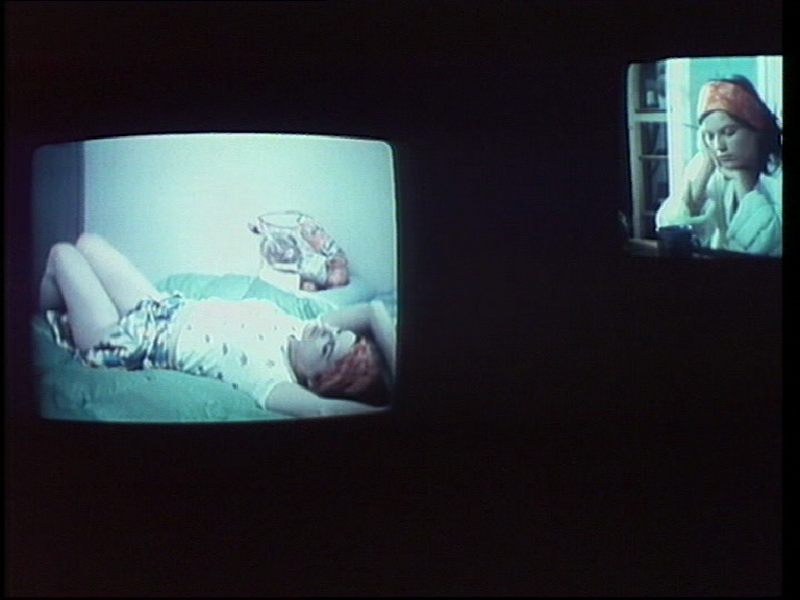
(5) Sound (She), Image (He) / Voice (She), Eye (He)
Which could also be written Sound (she) / Image (he) or, more precisely: Voice (She) / Eye (He). By talking too much about “images and sounds” in the abstract, we failed to notice that there was always and above all a body invoked. The Godardian body is what receives, what lodges the eye, it is the image. The image is the domain of the man (even when – Numéro Deux – nothing remains of it but fetal blackness), it is what he is accountable for. He is accountable for it as filmmaker (the overwhelming majority of filmmakers are men), therefore as a voyeur. Cinema, voyeurism: matters of the scopic drive, the erectile eye, the business of men until now. But he only accounts for it because someone talks to him about it. Someone: a voice, a voiceover, always the voice of a woman.
The voice of the woman as oral penis. It articulates the law, but a law made to order; what subjects the images, these images, his images. In the second part of le Vent d’est it is the voice of a woman which makes him draw the lesson: “What to do? You’ve made a film. You’ve criticized it. You’ve made mistakes. You know more now, perhaps, about the production of sounds and images, etc.” The same dispositive in Ici et Ailleurs, where it is again the voice of a woman that translates, unfolds, restores these images, already seen, too quickly run (“run out the ass,” as they say). The very theater of Tout va Bien is one where the same division of roles is at work. She (Jane Fonda) works for the radio (the voice: political commentary). He (Yves Montand) works in cinema (the image: commercials). And this voice speaks only about the meaning of events (’68), about History, about the meaning of History. And this image is one of prostituted bodies prancing for the greater glory of Dim stockings and the shameful pleasure of the man who films them. It’s by the voice that History descends on these images as what guts them, marks them, subjects them to its law. By the voice of a woman.
The body of the man is a bulging eye, the body of the woman is a voice which never stops intervening, questioning. Numéro Deux: even the disposition of bodies for love – posture – is at stake: “Why do you always want it like this?” asks Sandrine (neither “in” or “of”: she is simply disposed for Pierre’s eye – and for that of the camera). But the voice of Sandrine speaks only of one thing: of the image where she is and the position she occupies in it. Maximum proximity between bodies and thoughts: anchoring of what is said in what is seen.
Godard’s strange feminism: he puts the woman (the voice, the sound) in the place of what articulates the law (la pensée de manche*, of which we’ve understood that it is invested with a phallic character) and of what gives life. Perversion. It’s not clear that feminist demands are satisfied with this “place” the men no longer want, with this “power” which they’ve let drop. They don’t necessarily gain by it (even if the man reaps his profit of masochism: being the metteur en scène who says how he wishes to be punished, what type of cruel mothering he enjoys.) They didn’t necessarily gain by it when, at the time of La Chinoise and Le Vent d’est, they were put in the place of a discourse (Marxist-Leninist) which nobody wanted any part of. Anne Wiazemsky’s voice (and the bourgeois class-being it connoted) made it impossible for anyone to identify with this discourse and this truth.
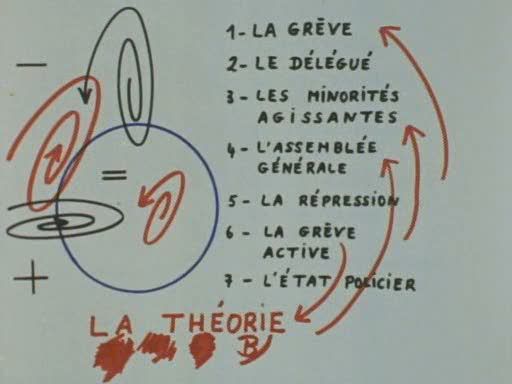
(6) Godard’s leftism means bringing down the barriers. Between private life and public life, work and leisure, the stage of History and the behind-the-scenes of daily life. But it’s a sad, super-egoistic, moral leftism: private life becomes public (and the bed a theater: Tout va bien, Numéro deux), leisure time (wasted in going to the cinema) becomes working time (seeing the film is work, work for the eye and the ear). Godard makes “a whole history” (toute une histoire) out of daily life. Making love, going to the cinema: hard labour.
(7) To sum up: the photograph retains once and for all (but what does it retain if not the real as impossible?). The cinema is subjected to the syncopation of images and sounds taken here to be returned elsewhere (and in the meantime there is this exercise, this pensum, which consists in retaining them, holding them back: like school, or constipation). Television never retains anything. Images and sounds file past (march past, parade in line, like soldiers) at the bidding of an anonymous power. As the passageway for this diarrhoea of images and sounds, television is the other horizon of Godard’s “cinema”: the place where things are for ever being churned out mechanically, the place which isn’t concerned with morals (choice, bad conscience), which knows only two possibilities: it works/it doesn’t work. Passageway, meeting place, eating house: horrible.
“The psychotic’s body appears, if you like, as an inert cylindrical surface, a kind of screen where imaginary productions are inscribed without giving rise to a meaning effect. It can keep nothing, retain nothing, appropriate nothing. It can receive nothing from … give nothing to … conceive of nothing for itself. It lays itself open to constant manipulation. But this way of putting it is misleading: it gives the psychotic’s body the status of a self-reflective subject (“it lays itself open”). It would be better to say: it is “laid open” (by everyone and no one).” Denis Vasse, L’ombilic et la voix. Deux enfants en analyse (p. 94).
——————————————————————————————————————————————————————-
translator’s notes
*Discours or pensée du manche: literally, the discourse or thought of the handle. Implicit in this Daneyism is the idea of “being on the right side” (the handle by which the tool must be grasped) and, of course, the image of the phallus. It also glances at Lacan’s term for the language of the obsessional neurotic: “le Discours du Maitre” (the Discourse of the Master.) It is better left untranslated. (Bill Krohn and Charles Cameron Ball)
* Différance: French term coined by Jacques Derrida, deliberately homophonous with the word “différence”. Différance plays on the fact that the French word différer means both “to defer” and “to differ.”